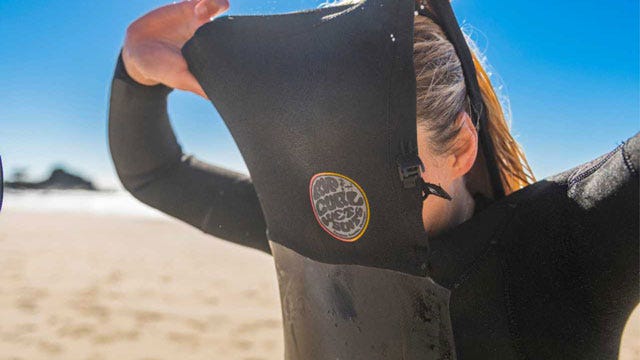

Wetsuit Care: How to Clean, When to Replace, and More


Proper care can extend your wetsuit's lifespan. See how to clean, maintain and store your wetsuit, when to replace and recycle it, plus a few hacks, tips and tricks in between.
A pristine Rip Curl wetsuit is a thing of beauty. You’re practically invincible in that rubber super-suit. Your non-surfing friends think you’re as tough as nails. Landlubbers are in disbelief when you tell them about suiting up, marching into pre dawn light, and wading out into the grey abyss …with an ear-to-ear grin no less. Little do they know that you’re packing Rip Curl and that you’re the beneficiary of 50+ years of R&D. Take our Flashbomb collection for example: There's the super heated stretch of our V2 flex energy that heats you while you move. Flash-Lining that makes yours the world’s fastest drying wetsuit - so you never put on a sopping wet wetty. Zip-free entry system, sweeping unbroken panels and less seams that make for a comfier kit with ultimate stretch. In short, you might be in ice water, but you’re hotter than a stolen tamale.
On the other hand, a scraggly old maltreated wetsuit can be a real drainer. Literally. Tears in the neoprene, salt-encrusted zips that won’t budge, seams that suck cold water into your suit and corral chilled chunks of ocean directly to your nether-regions. You can’t patiently wait for waves, you have to paddle in circles or tread water to keep core temp up and stave off the hyperthermia. Eventually your extremities call it a day and you end up paddling in with splayed fingers, looking like Edward Scissorhands. How did you get here? And what can you do to ensure it never happens again?
A high-quality wetsuit is an investment that requires some extra attention to detail to reduce the effects of UV rays, salt water, sand, dirty parking lots, big waves and more. Read on and treat your suit right!
General Wetsuit Care
Your wetsuit care starts as soon as you put it on. Put your wetsuit on with care, don’t rush it and risk the chance of snagging or poking the fabric, breaking the zipper, or tearing a seam. Keep in mind the special materials and smooth panels on your suit and where they are placed and avoid pulling from these points where possible.


Once you’re in the water, though it might be hard to avoid during those long, cold sessions, the less you pee in your suit the better! It’ll keep your wetsuit fabric fresh for longer, and you won’t have to try to wash out the scent as often.
After you’re done hitting the waves, take off your wetsuit as soon as possible. It’ll be easier before it dries, and the sooner you take it off, the less sand and sweat you’ll get on it, which means less mess to clean off later. Pro tip: Use a changing mat and changing poncho and keep your wetsuit inside-out once you take it off for easier cleaning and drying later on.
The main things to keep in mind for wetsuit care are:
-
Put on and take off carefully
-
Avoid contact with sand and ground
-
Wash with cold, fresh water after every surf
-
Dry in the shade, starting inside-out
-
Store in a cool, dry place on a wide hanger or lay flat
How to Clean a Wetsuit
For surfers, saltwater is a natural anti-anxiolytic. It’s a revitalising way for you to unplug, reset, and get back to nature, afterwards you’re feeling fresh… but it’s not so for your wetty. When the seawater dries and salt crystallises it has a corrosive effect on neoprene and hardware. It can destroy the fibres, eat away at stitching, and without intervention leads to water coursing through holes and your body temp plummeting. A chilling prospect. Fortunately, a quick rinse with fresh water after every surf can nip this in the bud. When it comes to cleaning your wetsuit, you want to rinse with simple, cold fresh water. The sooner you wash your wetsuit after getting out of the water, the better. No washing machine, no hot water, no laundry detergent, no fabric softener, and no bleach. You can hose down your wetsuit, or you can fill a tub with fresh water and give your suit a few dunks.
After every surf, you want to do a thorough rinse both inside and out to remove any sand, salt water, sweat, or anything else your wetsuit might have grabbed on to during your session. Any leftover grime can cause smells or damage the material over time. If there is surf wax on your wetsuit (there probably is), don’t try to remove it. There’s no real way to remove it effectively without damaging your suit in the process and it’s not harmful to the suit.
Is there a smell that lingers on your wetsuit? Even with proper cleaning care after every session, your wetsuit will still hold on to some smells over time. You don’t have to use it every time you clean your wetsuit, but using a wetsuit cleaning product like Rip Curl’s PissOff detergent is the best solution for stubborn odours. It’s a great and economical way to invest in the longevity of your neoprene products and ensure the durability, stretch and comfort properties remain in ultimate form and get rid of that unwanted pong. Its scientific formula helps eliminate bacterial build up and fight odours ...If you ever warm up in the water by “breaking the seal”, it’s worth getting.
How to Dry a Wetsuit
You’ve rinsed your wetsuit and it’s time to dry. A bit of Vitamin D does wonders for the soul but the sun’s UV rays also damage wetsuits. It can be enticing to hang your wetty in direct sunlight, especially if you’re keen to surf again later, or first thing in the morning. Although it may dry slightly faster, this short term gain won’t be worth the pain of your suit deteriorating more rapidly over its lifetime and losing its stretch and comfortability.


So, it’s best to hang your wetsuit to dry in the shade. Start by drying it inside-out to help prevent mildew, then turn it right-side-in to finish drying. This will also help if you have another session coming up quickly, you can at least step into the dry side instead of struggling to put on a wet, cold suit! When drying, hang your wetsuit over a smooth, round surface, such as a balcony railing, shower rod, or the bar on a wide hanger. Hang it at the waist with an equal balance on each side.
You should also NEVER put your wetsuit in the dryer and don’t try to iron your wetsuit either. Ever. If you surf heaps and can’t stand getting into a wet wetsuit, get yourself a Flashbomb fitted with Flash-lining. This revolutionary exclusive Rip Curl technology wicks away water and is touch dry in 30 min. Also, to fast track drying, give the wrists and ankles a gentle squeeze 10 min after hanging to quickly drain out water pooling there.
How to Store a Wetsuit
Before you store your wetsuit, it is important to make sure your suit is totally dry. If there’s any moisture, you run the risk of mould and mildew, which will both smell pretty bad and ruin the material. A little patience goes a long way! Once your wetsuit is dry, have a cool and dry space to store it. Choose a spot that doesn’t get exposed to direct sunlight. Avoiding the garage might also be a good call, as car fumes and high heat can damage the fabric.
You can store it hanging by folding it over the bar of a wide hanger while equally balanced or by using a thick hanger with wide, rounded shoulders that will prevent indents forming in the shoulders. Large hangers also allow airflow while your suit is hanging. Storing your wetsuit by laying it flat is also an option if you have the space! This wetsuit storage option is great for avoiding creases or fabric stretching that can occasionally happen when hanging.


When to Get a New Wetsuit
After some time, even with great care, your trusty wetsuit will start to show some wear after you’ve enjoyed plenty of sessions together. Wetsuits can last up to 10 years, depending on how heavily you use them. While you’re cleaning and storing your wetsuit, keep an eye out for signs of wear that might require attention.
Some holes, busted seams, and stuck zippers can be easily fixed with the right products and help extend your wetsuit’s life, but it’s best to check your wetsuit warranty first before making any repairs yourself - our team of experts can do it for you if it’s covered! At Rip Curl, your wetsuit warranty includes 3 years on all stitching, 12 months on materials and constructions, and 12 months on Aquaban liquid tape if damage is caused by defects in materials or workmanship - it doesn’t apply to normal wear and tear, improper storage, failure to follow instructions, and fin cuts.
It might be time to get a new wetsuit if you’re experiencing any of the following:
-
Too many holes, or holes that are too big to patch
-
Large sections of weak or busted seams
-
Stretched, thinning, dried, or cracking neoprene
-
Fabric no longer providing proper temperature control
-
Unwanted scent that won’t go away
-
Wetsuit is getting too small or large
With the proper wetsuit care, your suit is sure to last. Take the extra time to learn how to clean and store your wetsuit to protect your surfing investment, and enjoy catching waves for years to come.
Recycle Your Old Wetsuit
When you’re finally ready to retire your old wetsuit, don’t just throw it in the bin. Give your wetsuit a second life with our wetsuit take-back recycling program. All recycled rubber will now be repurposed for use in the safety attenuation layer of soft fall matting used at playgrounds and outdoor gyms.
Check out our participating stores and the full story.



